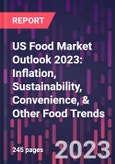Report Overview
Most major packaged food categories are mature and rely primarily on population growth, leaving food marketers with the challenge of bringing something new to the table. Opportunities abound for companies that invest in new product launches, ingredient changes, and different marketing tactics to appeal to changing consumer preferences. Some trends in 2023 - like inflation - are continuations of 2022 issues while others - like sustainability - are trends that are resurfacing in a bigger way again after having taking a back seat to other concerns in the height of the pandemic.
Inflation-fueled higher prices are a core trend from 2022 that is continuing in 2023, as supply challenges, higher ingredient and energy prices, and rising labor costs combine to test suppliers, retailers, and consumers. This has led to consumers seeking value, whether that means in comparison to the price of dining out or in comparison to routine grocery items, with private label options seeing surges across all categories. Additionally, food shoppers are increasingly placing sustainability at a higher priority level again, with plant-based options, clean labels, sustainable supply chains, and recyclable and reduced packaging as key trends. Furthermore, shoppers are presenting preferences with contradictions as they are looking for indulgence, but better-for-you versions, and chef-inspired menus, but with convenient preparation.
With a focus on growth opportunities and “what’s next” - along with bringing decades of food and beverage market perspective and analysis to the table - U.S. Food Market Outlook 2023: Inflation, Sustainability, Convenience, & Other Food Trends is packed with actionable insights about consumer trends, behavior, and motivations. This report delivers predictions and recommendations designed to guide retailers, service providers, wholesalers, food processors, packaging firms, and investors in making business decisions about the food market.
Scope
Combining the publisher's extensive monitoring of the food and beverage market with proprietary surveys, U.S. Food Market Outlook 2023 is the go-to source for a complete understanding of the U.S. food market. This broad-based report evaluates current trends and future directions for marketing and retailing, along with consumer patterns across the food market.
U.S. Food Market Outlook 2023 examines product availability; surveys retail channel trends; and analyzes consumer trends and motivations. This report focuses on the market for selected food products sold to consumers in the United States through retail channels. All retail channels of distribution are covered in market sizing and discussion, including supermarkets and grocery stores, mass merchandisers and supercenters, warehouse clubs, natural food stores, convenience stores, drugstores, dollar stores, and direct-sales channels including online. Market size data and projections are provided at the retail sales level.
Report Methodology
The information contained in U.S. Food Market Outlook 2023 was developed from a variety of primary and secondary research sources.
Primary research includes interviews with food and beverage market experts and participation in and attendance at food industry events. Primary research also includes national online consumer polls of U.S. adult consumers (age 18+) conducted on an ongoing basis by the publisher to analyze purchasing patterns and attitudes with regard to food and beverage preferences. Supplementing the publisher's exclusive survey is an extensive analysis of MRI-Simmons’ National Consumer Study, which is based on approximately 25,000 adult respondents surveyed annually.
Secondary research entailed gathering data from relevant trade, business, and government sources, as well as company promotional literature and annual reports.
This report contains dozens of numerical tables and charts, as well as numerous product photographs. Our estimates of market size and company performance are based on various sources including reported revenues of product manufacturers and retailers, relevant publications, and other market research sources. The analysis in this report also draws, as a background source, on retail sales tracking data from mass market and specialty channels.








